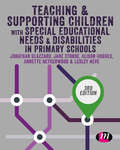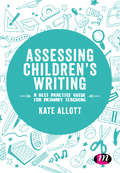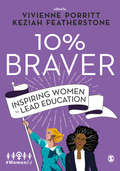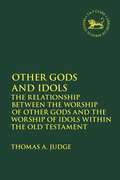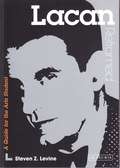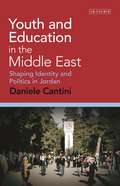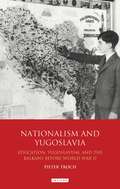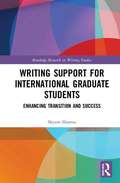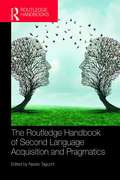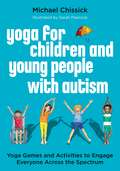- Table View
- List View
Bhugol B.A (Hons.) Sem-I -Ranchi University, N.P.U
by Chaturbhuj Mamoria Ratan JoshiBhugol textbook for B.A (Hons.) Sem-I from Ranchi University, Nilambar Pitambar University in Hindi.
Teaching and Supporting Children with Special Educational Needs and Disabilities in Primary Schools (Achieving QTS Series)
by Jonathan Glazzard Jane Stokoe Alison Hughes Annette Netherwood Lesley NeveThis book begins by exploring what is meant by SEND in primary schools and goes on to cover everything trainees and teachers need to know about their statutory responsibilities in school. It then examines the range of needs they will encounter in primary schools with plenty of practical advice along the way. This third edition has been fully restructured and updated to include a new section on the key theories and theorists relating to SEND. Also new to this edition is a chapter focusing on the role of the SENCO in primary school. Finally, the book includes more practical support with coverage of current legislation and the Code of Conduct as well as checklists and information about useful resources and outside agencies.
Assessing Children's Writing: A best practice guide for primary teaching (Exploring the Primary Curriculum)
by Kate AllottThis book supports teachers and trainee teachers with the assessment of writing, and particularly assessment as part of the cycle of planning and teaching – assessment used formatively. - Explores the issues and challenges in the assessment of writing - Highlights the importance of specific feedback - Features examples of children's work and detailed guidance on how to assess each piece - Includes a chapter on supporting children to write more outside of school
10% Braver: Inspiring Women to Lead Education
by Vivienne Porritt Keziah Featherstone62% of teachers in secondary schools are women but only 39% of secondary headteachers are female Only 7% of women in education will attempt to negotiate their initial salary offer, compared to 57% of their male counterparts 1 in 4 teachers who quit the classroom in recent years were women aged 30–39 What would you do to make a change today if you were 10% braver? This is the ultimate guide for women in education. Written by leading members of the grassroots #WomenEd movement, it offers guidance on how to attain and succeed in leaderships positions, alongside nuanced analysis and debate of topics including: the gender pay gap, gender stereotyping in schools and beyond, the realities experienced by BME leaders and how flexible working cultures can redress inequities. Each chapter gives advice on how we can all change things for the better, as individuals, in our schools, and across the system, and how you can be part of the #WomenEd movement to improve equality in education for everyone. *** "This book matters because it is guaranteed to inspire, to educate and to spark a much-needed clamour for women to assume roles of influence throughout our education system." -Alison Peacock, Chief Executive of the Chartered College of Teaching ***
Other Gods and Idols: The Relationship Between the Worship of Other Gods and the Worship of Idols Within the Old Testament (The Library of Hebrew Bible/Old Testament Studies)
by Thomas A. JudgeThis study questions why the relationship between the worship of other gods and the worship of idols within the Old Testament is difficult to define, acknowledging how various traditions have seen these two issues as synonymous and others have viewed them as separate commandments.Judge argues that there are four factors at play in this diversity. He introduces the first three through an examination of the relationship between the prohibitions listed in the biblical text, and the fourth through a study of the biblical depiction of the war against idols before and after the fall of the Northern Kingdom. Judge argues that texts depicting the era before the fall provide a context in which there are strong grounds to distinguishing the worship of the “wrong gods” and the worship of the right God in the wrong way. However, texts depicting the era after the fall provide a context in which the issues appear to have been fused.
The Fear of God in 2 Corinthians 7: Its Meaning, Function, and Eschatological Context (The Library of New Testament Studies)
by Euichang KimEuichang Kim focuses upon the phrase “the fear of God”, drawn from 2 Corinthians' exhortation to reconcile with God. As opposed to these words appearing from no particular source, Kim points to the wider contexts of Old Testament passages quoted by Paul, and demonstrates that God's eschatological promises – in particular his coming judgment, his promise to redeem his people, and the prospect of a new covenant – are intertwined with this motif of “fear”.Beginning with an analysis of the meaning of fear in both the Old Testament and the New, Kim proceeds to the context of fear within 2 Corinthians, Scripture, the writings of Second Temple Judaism and the very eschatology of Paul, suggesting that it stems from an awareness of God's judgment to come and serves to motivate righteous behavior. Kim finally argues that, in the context of 2 Corinthians, the “fear of God” functions as the proper response to God's saving acts in Christ, and provides motivation for believers to pursue a holy life in anticipation of the eschatological judgment to come.
The Fear of God in 2 Corinthians 7: Its Meaning, Function, and Eschatological Context (The Library of New Testament Studies)
by Euichang KimEuichang Kim focuses upon the phrase “the fear of God”, drawn from 2 Corinthians' exhortation to reconcile with God. As opposed to these words appearing from no particular source, Kim points to the wider contexts of Old Testament passages quoted by Paul, and demonstrates that God's eschatological promises – in particular his coming judgment, his promise to redeem his people, and the prospect of a new covenant – are intertwined with this motif of “fear”.Beginning with an analysis of the meaning of fear in both the Old Testament and the New, Kim proceeds to the context of fear within 2 Corinthians, Scripture, the writings of Second Temple Judaism and the very eschatology of Paul, suggesting that it stems from an awareness of God's judgment to come and serves to motivate righteous behavior. Kim finally argues that, in the context of 2 Corinthians, the “fear of God” functions as the proper response to God's saving acts in Christ, and provides motivation for believers to pursue a holy life in anticipation of the eschatological judgment to come.
Unframed: Practices and Politics of Women's Contemporary Painting
by Rosemary BettertonThe first sustained analysis of the relationship between women's contemporary painting and feminism. This international collection of specially commissioned pieces brings together writing both by theorists engaged with the process and practice of painting and practitioners engaged in theory, to bring into question what has been a neglected area within feminist literature on visual culture.Looking at gender, subjectivity, spectatorship, the gendered audience and maternal subjectivity and painting, Unframed encourages reflexivity about the practice and includes in its scope a range of processes including drawing, printing, collage and installation. The process of painting and the materiality of paint, haptic vision and the contemporary sublime are all discussed. Lavishly illustrated in black and white, Unframed will be of interest to practitioners and students of fine art, art history and women's studies.
From Mission to Modernity: Evangelicals, Reformers and Education in Nineteenth Century Egypt (Library of Middle East History)
by Paul SedraIn this pioneering account of Egyptian educational history, Paul Sedra describes how Egypt, under Muhammad Ali Pasha, sought to forge a new relationship between the state and its children during the nineteenth century. Through the introduction of modern forms of education, brought to Egypt by evangelical missions, the state aimed to ensure children's loyal service to the state. However, these schemes of educational reform led to unforeseen consequences.Paul Sedra follows the path of one particular educational method, Joseph Lancaster's monitorial system, from its origins in Madras and south London, through its adoption by Christian missionaries as a favoured technique, to its arrival in Egypt as part of the Church Missionary Society's effort to convert Coptic Christians to an evangelical Christianity. Sedra then steps beyond the blueprints of the monitorial school to examine how modern educational techniques were adapted to an Egyptian context. There were moments of contestation as to both the methods and the purposes of education - contestation between Anglican and Presbyterian missionaries, Ottoman and Egyptian officials, Coptic priests and Muslim reformers, and landowners of both faiths on the one hand, and the subaltern inhabitants of the Nile Valley on the other. Despite the missionary origins of monitorial schools in Egypt, the Egyptian state seized upon their techniques in order to establish a new type of relationship between thestate and children - one that would ensure children's loyal service to the state, whether through conscription or forced labour. State educationalists introduced monitorial methods into state schools as a means of ensuring discipline both within and beyond the classroom. Ultimately, modern Egyptian schools emerged from this process of adaptation as a venue for the inculcation of particular values, and sacred texts - whether the Qur'an or the Bible - were cast as codes of morality available for interpretation not only to accredited scholars of Islam and Christianity, but further, to state functionaries. Sedra also explores how students resisted efforts to control their behaviour in creative and complex ways, and how their acts of resistance themselves led to new forms of political identity. In opposing the state's efforts at social control, for instance, students turned to a new cadre of religious leaders, both Christian and Muslim, who suggested that reformation of the faith would reinvigorate Egyptian society, and ultimately enable them to overturn imperialism, whether of the Ottoman or the British variety. Tracing the development of a distinctly Egyptian 'modernity', 'From Mission to Modernity' is indispensable for all those interested in Egyptian history and the history of modern education and reform.
Lacan Reframed: Interpreting Key Thinkers for the Arts
by Steven Z. LevineAre your students baffled by Baudrillard? Dazed by Deleuze? Confused by Kristeva? Other beginners' guides can feel as impenetrable as the original texts to students who 'think in images'. "Contemporary Thinkers Reframed" instead uses the language of the arts to explore the usefulness in practice of complex ideas. Short, contemporary and accessible, these lively books utilise actual examples of artworks, films, television shows, works of architecture, fashion and even computer games to explain and explore the work of the most commonly taught thinkers. Conceived specifically for the visually minded, the series will prove invaluable to students right across the visual arts. Single-handedly responsible for the influential and ominous notion of 'the gaze', quoted by everybody yet fully understood by few, Lacan's work can be difficult to grasp. Going back to basics, this introduction guides the reader through Lacan's key concepts by looking at art from the Mona Lisa through to Bridget Riley's paintings, and by looking afresh at key works discussed by Lacan himself, from Holbein's famous 'The Ambassadors' to Velazquez's 'Las Meninas'.Making sense of Lacan's sometimes convoluted style, this highly readable introduction to one of the most frequently quoted thinkers also explores the reasons why human beings make - and look at - art.
Jesus and the Rise of Nationalism: A New Quest for the Nineteenth Century Historical Jesus
by Halvor MoxnesThe great German theologian Albert Schweitzer famously drew a line under nineteenth-century historical Jesus research by showing that at the bottom of the well lay not the face of Joseph's son, but rather the features of all the New Testament scholars who had tried to reveal his elusive essence. In his thoughtful and provocative new book, Halvor Moxnes takes Schweitzer's observation much further: the doomed 'quest for the historical Jesus' was determined not only by the different personalities of the seekers who undertook it, but also by the social, cultural and political agendas of the countries from which their presentations emerged. Thus, Friedrich Schleiermacher's Jesus was a teacher, corresponding with the role German teachers played in Germany's movement for democratic socialism. Ernst Renan's Jesus was by contrast an attempt to represent the 'positive Orient' as a precursor to the civilized self of his own French society. Scottish theologian G A Smith demonstrated in his manly portrayal of Jesus a distinctively British liberalism and Victorian moralism. Moxnes argues that one cannot understand any 'life of Jesus' apart from nationalism and national identity: and that what is needed in modern biblical studies is an awareness of all the presuppositions that underlie presentations of Jesus, whether in terms of power, gender, sex and class. Only then, he says, can we start to look at Jesus in a way that does him justice.
Youth and Education in the Middle East: Shaping Identity and Politics in Jordan
by Daniele CantiniThe uprisings that were seen throughout the Middle East during 2010 and 2011, make it difficult to over-state the role of educated youth in the region s politics. Daniele Cantini combines an analysis of young people in Jordan, of its relevance and of its perceived crisis, with one which looks at education and the pursuit of knowledge. He thereby highlights the unprecedented rise in youth population and the growth in institutions of higher learning as a way to explore and explain the challenges Arab-majority societies are currently facing. It proposes an understanding of the university as an institution integral to the survival of the regime, discusses its fragile reforms, and crucial in the formation of young people s social and political identities. Youth and Education in the Middle East, offers vital first-hand accounts of the role of educational institutions and the impact they have in shaping transnational and local constituencies as well as in the micropolitics of everyday life."
Nationalism and Yugoslavia: Education, Yugoslavism and the Balkans before World War II
by Pieter TrochCreated after World War I, 'Yugoslavia' was a combination of ethnically, religiously, and linguistically diverse but connected South Slav peoples - Slovenes, Croats and Serbs but also Bosnian Muslims, Macedonians, and Montenegrins - in addition to non-Slav minorities. The Great Powers and the country's intellectual and political elites believed that a coherent identity could be formed in which the different South Slav groups in the state could identify with a single Balkan Yugoslav identity. Pieter Troch draws on previously unpublished sources from the domain of education to show how the state's nationalities policy initially allowed for a flexible and inclusive Yugoslav nationhood, and how that system was slowly replaced with a more domineering and rigid 'top-down' nationalism during the dictatorship of King Alexander I - who banned political parties and coded a strongly politicised Yugoslav national identity. As Yugoslav society became increasingly split between the 'pro-Yugoslav' central regime and 'anti-Yugoslav' opposition, the seeds were sown for the failure of the Yugoslav idea.Nationalism and Yugoslavia provides a valuable new insight into the complexities of pre-war Yugoslavia.
Cyber-bullying: Issues and Solutions for the School, the Classroom and the Home
by Shaheen ShariffThis book looks in depth at the emerging issue of cyber-bullying. In this increasingly digital world cyber-bullying has emerged as an electronic form of bullying that is difficult to monitor or supervise because it often occurs outside the physical school setting and outside school hours on home computers and personal phones. These web-based and mobile technologies are providing young people with what has been described as: ‘an arsenal of weapons for social cruelty’. These emerging issues have created an urgent need for a practical book grounded in comprehensive scholarship that addresses the policy-vacuum and provides practical educational responses to cyber-bullying. Written by one of the few experts on the topic Cyber-Bullying develops guidelines for teachers, head teachers and administrators regarding the extent of their obligations to prevent and reduce cyber-bullying. The book also highlights ways in which schools can network with parents, police, technology providers and community organizations to provide support systems for victims (and perpetrators) of cyber-bullying.
Cyber-bullying: Issues and Solutions for the School, the Classroom and the Home (PDF)
by Shaheen ShariffThis book looks in depth at the emerging issue of cyber-bullying. In this increasingly digital world cyber-bullying has emerged as an electronic form of bullying that is difficult to monitor or supervise because it often occurs outside the physical school setting and outside school hours on home computers and personal phones. These web-based and mobile technologies are providing young people with what has been described as: ‘an arsenal of weapons for social cruelty’. These emerging issues have created an urgent need for a practical book grounded in comprehensive scholarship that addresses the policy-vacuum and provides practical educational responses to cyber-bullying. Written by one of the few experts on the topic Cyber-Bullying develops guidelines for teachers, head teachers and administrators regarding the extent of their obligations to prevent and reduce cyber-bullying. The book also highlights ways in which schools can network with parents, police, technology providers and community organizations to provide support systems for victims (and perpetrators) of cyber-bullying.
Writing Support for International Graduate Students: Enhancing Transition and Success (PDF) (Routledge Research In Writing Studies)
by Shyam SharmaUsing qualitative data collected from more than twenty universities across the US, Writing Support for International Graduate Students describes and theorizes agency- and advocacydriven practices, programs, and policies that are most effective in helping international students learn graduate-level writing and communication skills. It uses compelling narratives and cases to illustrate a variety of program models and support practices that fostered the students’ process of academic transition and success. Employing an ecological framework, the book seeks to advance academic conversation about how writing scholars/instructors and program administrators, as well as other academic service professionals working with this student body, can formulate policies, develop programs, and implement practices that best help these students grow as writers and scholars in their disciplines.
Writing Support for International Graduate Students: Enhancing Transition and Success (Routledge Research In Writing Studies)
by Shyam SharmaUsing qualitative data collected from more than twenty universities across the US, Writing Support for International Graduate Students describes and theorizes agency- and advocacydriven practices, programs, and policies that are most effective in helping international students learn graduate-level writing and communication skills. It uses compelling narratives and cases to illustrate a variety of program models and support practices that fostered the students’ process of academic transition and success. Employing an ecological framework, the book seeks to advance academic conversation about how writing scholars/instructors and program administrators, as well as other academic service professionals working with this student body, can formulate policies, develop programs, and implement practices that best help these students grow as writers and scholars in their disciplines.
Home Economics: OCR Child Development for GCSE (PDF)
by Carolyn MeggittEndorsed by OCR for use with the OCR GCSE Home Economics: Child Development specification, this book is a clear and informative introduction to all aspects of child development. Written by a bestselling author in this field, it is filled with colourful diagrams, illustrations and photos to help bring the subject to life. Activities and practical tasks throughout are aimed at a range of ability levels, ensuring all students can access the material. Contents: 1. Family and Parenting 2. Preparation for Pregnancy and Birth 3. Physical development 4. Nutrition and Health 5. Intellectual, Social and Emotional Development 6. Community Support 7. About the coursework (controlled assessment) 8. Exam preparation 9. Glossary
The Routledge Handbook of Second Language Acquisition and Pragmatics (The Routledge Handbooks In Second Language Acquisition Ser.)
by Naoko TaguchiThe Routledge Handbook of Second Language Acquisition and Pragmatics is a comprehensive critical survey of the field of L2 pragmatics, collecting a number of chapters that highlight the key theories, methods, pedagogies, and research findings throughout its development over the last four decades. Demonstrating the ways in which pragmatics has long served as a lens through which to examine L2 development, the volume is divided into six parts which reflect the field’s structure and evolution: • Constructs and units of analysis • Theoretical approaches • Methodological approaches • Pedagogical approaches • Contextual and individual considerations • L2 pragmatics in the global era The handbook has a particular focus on covering not only traditional topics in the field, such as constructs of pragmatic competence (e.g., speech acts, implicature), teaching and assessment, and pragmatics learning in a study abroad program, but also emerging areas of study, including interactional pragmatics, intercultural pragmatics, usage-based approaches, corpus linguistics, and psycholinguistic experimentation. Each chapter introduces the topic and follows with a description of its theoretical underpinnings, an overview of existing literature, appraisal of current practice, concluding with a discussion of future directions for research and key readings. The Routledge Handbook of Second Language Acquisition and Pragmatics is an essential resource for those with an interest in second language acquisition, pragmatics, and applied linguistics.
The Routledge Handbook of Second Language Acquisition and Pragmatics (The Routledge Handbooks In Second Language Acquisition Ser.)
by Naoko TaguchiThe Routledge Handbook of Second Language Acquisition and Pragmatics is a comprehensive critical survey of the field of L2 pragmatics, collecting a number of chapters that highlight the key theories, methods, pedagogies, and research findings throughout its development over the last four decades. Demonstrating the ways in which pragmatics has long served as a lens through which to examine L2 development, the volume is divided into six parts which reflect the field’s structure and evolution: • Constructs and units of analysis • Theoretical approaches • Methodological approaches • Pedagogical approaches • Contextual and individual considerations • L2 pragmatics in the global era The handbook has a particular focus on covering not only traditional topics in the field, such as constructs of pragmatic competence (e.g., speech acts, implicature), teaching and assessment, and pragmatics learning in a study abroad program, but also emerging areas of study, including interactional pragmatics, intercultural pragmatics, usage-based approaches, corpus linguistics, and psycholinguistic experimentation. Each chapter introduces the topic and follows with a description of its theoretical underpinnings, an overview of existing literature, appraisal of current practice, concluding with a discussion of future directions for research and key readings. The Routledge Handbook of Second Language Acquisition and Pragmatics is an essential resource for those with an interest in second language acquisition, pragmatics, and applied linguistics.
The Role of Technology in Distance Education (Routledge Revivals)
by Tony BatesThis book, first published in 1984, provides a comprehensive review of the range of technology that was being used in distance education. Technological developments in word processing, video-disc and viewdata as well as computer-based learning had revolutionised the potential for distance education. These developments required the role of more ‘conventional’ distance learning media, such as broadcasting, tuition and text, to be reassessed. This book, written by international experts in the field, explored the state of the art at the time, and also provided their ideas on how future developments were likely to evolve. This book is ideal for those studying education and communications.
The Role of Technology in Distance Education (Routledge Revivals)
by Tony BatesThis book, first published in 1984, provides a comprehensive review of the range of technology that was being used in distance education. Technological developments in word processing, video-disc and viewdata as well as computer-based learning had revolutionised the potential for distance education. These developments required the role of more ‘conventional’ distance learning media, such as broadcasting, tuition and text, to be reassessed. This book, written by international experts in the field, explored the state of the art at the time, and also provided their ideas on how future developments were likely to evolve. This book is ideal for those studying education and communications.
Introducing a School Dog: Our Adventures with Doodles the Schnoodle
by Cherryl DrabbleAnimal Assisted Therapy is becoming increasingly popular in education settings, but there is very little information on how to implement it. This practical guide provides everything you need to know to introduce a therapy dog, and the various benefits that a dog can have for pupils, from young children to teenagers.
Introducing a School Dog: Our Adventures with Doodles the Schnoodle
by Cherryl DrabbleAnimal Assisted Therapy is becoming increasingly popular in education settings, but there is very little information on how to implement it. This practical guide provides everything you need to know to introduce a therapy dog, and the various benefits that a dog can have for pupils, from young children to teenagers.
Yoga for Children and Young People with Autism: Yoga Games and Activities to Engage Everyone Across the Spectrum
by Michael ChissickSpeaking from decades of experience, Michael Chissick shares the secrets to teaching yoga to children and young people with Autistic Spectrum Disorder (ASD).The physical, emotional and social benefits of yoga for autistic children can be profound, and this book will give you the confidence to get going with an array of fun activities and games from 'chasing the frog' to 'yoga detective'. Whether you work in special needs school, primary mainstream school or the community, or you are the parent of an autistic child, this book will equip you with plans, structures, goals, teaching tips and a multitude of real-life stories.The book is suitable for teaching everyone on the spectrum, with an emphasis on teaching those with more complicated needs. It is also relevant for use with children who have related needs such as ADHD and sensory processing challenges. Beautifully illustrated with images of the postures taught within, it is the perfect go-to resource for anyone interested in engaging children and young people in yoga.I can be a banana, can you?Suitable for ages 4-11

